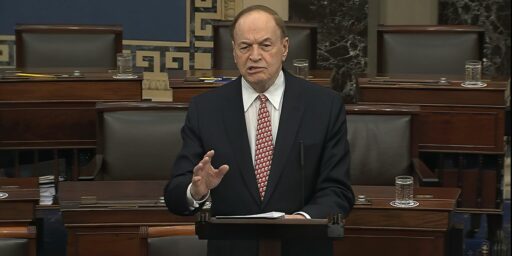Justice Dept. Files Challenge Against Texas Redistricting
Notwithstanding last month’s Supreme Court decision on Section 5 of the Voting Rights Act, the Justice Department is moving forward with a challenge to Texas’s redistricting plan:
Despite the Supreme Court’s ruling in late June that weakened the Voting Rights Act, Attorney General Eric Holder says the Justice Department will use what’s left of the law to go after what it considers discriminatory practices.
And the first target will be Texas, in a dispute over new boundaries drawn by the Republican legislature for congressional and legislative districts.
Holder told National Urban League this morning that the Justice Department’s Civil Rights division will urge a federal judge in Texas to subject the State of Texas to a pre-clearance regime similar to the one required by Section 5 of the Voting Rights Act — a part of the law that survived the Supreme Court’s ruling.
“This request to ‘bail in’ the state — and require it to obtain pre-approval from either the department or a federal court before implementing future voting changes — is available under the Voting Rights Act when intentional voting discrimination is found,” he said.
Lyle Denniston expands on the story:
A three-judge U.S. District Court in San Antonio is now considering the question of whether to put Texas back under the preclearance requirement in a pending case involving new election districts for the Texas state legislature and for its membership in the House of Representatives. Advocacy groups for minority voters in the state have already asked that court to take that step. Texas, however, has cautioned that court that such a step might raise new constitutional issues, under the Section 5 provision is used only in quite narrow circumstances.
The advocacy groups have also asked a three-judge District Court in Washington to take the same step. That is the Court that fouond flaws in parts of the Texas redistricting maps in the case that the Attorney General mentioned – Texas v. Holder. The Supreme Court sent that case back to the District Court to apply the Shelby County decision. The Justice Department is due to file on Friday its views on the Section 3 question in that case.
In addition, it appears likely that the Section 3 issue will arise in another voting rights case involving Texas. That case, also sent back to a three-judge District Court by the Supreme Court to consider the impact of the Shelby County decision, involves the constitutionality of Texas’s controversial voter ID law. So far, there have been no followup filings in that case.
When the Court struck down Section 4’s preclearance formula, it was suggested that this would be the direction that the Justice Department would take. It’s going to take longer than pre-clearance would have, of course, and there’s a danger of inconsistent rulings. However, applied properly this could be just as powerful a method for enforcing the act as Section 4 has been.






Agreed. It’s not the best solution, but even back when Texas was under the preclearance regs, the federal judges sounded pretty convinced that this redistricting plan was pretty egregiously racist and illegal. It’s very likely that this plan will get the same treatment this time around, which kinda proves that the ruling against that part of the VRA was deeply flawed & the preclearance parts are still necessary, because some states just won’t grow up & act like mature adults.
The argument at the time seemed to be along the lines of “it’s been 50 years. Either the VRA has worked, and it’s time to let go, or it isn’t ever going to work, and we should try something else.” Either way, the VRA should not be going on in perpetuity.
And the standard for proof should be pretty damned high. Simply saying that the plan screws Democrats, and since minorities are more likely to be Democrats, it’s racial shouldn’t be sufficient.
@Jenos Idanian #13:
The VRA was used to prevent dozens, if not hundreds, of instances of racial discrimination in voting and elections. Is your argument that it “hasn’t worked” because it wasn’t able to end racism or resurrect Martin LuthernKing?
awesome, waste more time/money on nothingness.
Which fundamentally misstates the court’s ruling, which both sides seem to be doing. The ruling didn’t not legalize any practices that were formally illegal. All it did was change the procedure for enforcing those infractions, requiring them to be tried in court rather than allowing the DOJ to unilaterally veto them.
So this lawsuit isn’t “notwithstanding” that decision; it’s perfectly in tune with it.
The problem here is that with Section 2 you have to wait till AFTER the legislature passes its racially dioscriminatory scheme, and maybe even till after the election, then you have to finbd a plaintiff and file suit. Its just more cumbersome and expensive process .
The alacrity with which Texas and North Carolina filed their voter supression schemes after the Sheby decision made Roberts look like a buffoon, and athe belief that this Congress would act to fix Section 4 looks like more wishful thinking.
Taking away Section 5 was a boon to the neo Confederates, and it’s futile to pretend otherwise .
@Jenos Idanian #13: And in this case they have “smoking gun” emails discussing the racial impact that went into the planning of the districts.
http://tpmdc.talkingpointsmemo.com/2013/07/texas-voting-rights-act-redistricting.php
Republicans can’t win an election fair and square. So suppressing votes is there only hope! That is not democratic! It’s vote rigging and it must be stopped.
@SKI: in addition to removing the “economic engines” from minority districts they also removed the district offices of 4 minority district representatives.
Notwithstanding last month’s Supreme Court decision on Section 5 of the Voting Rights Act
Section 4, actually, tho that had the effect of neutering Section 5.
@Jenos Idanian #13:
Incorrect. The section of the VRA that was struck down allowed municipalities that required pre-clearance the opportunity to to get off that list. All they had to do was behave themselves for a period of 10 years. The fact that several places _did_ accomplish that is proof that the VRA was working. The fact that other areas – like Texas – couldn’t manage that level of maturity is also proof that the VRA was still needed. The Supreme Court screwed up completely, and should have left the entire VRA alone.
I’m with Lewis Black: F you, Texas
Shorter Jay Tea/Jenos:
The dam has been holding the water back fine for years. It worked. Time to get rid of it.
How shocking coming from people who have probably never had their right to vote denied to them or made more difficult for them because of the color of their skin and/or their ethnic background…